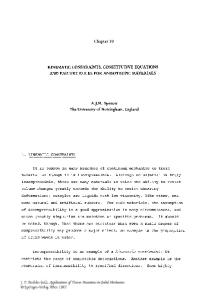Shake-Down Analysis for Perfectly Plastic and Kinematic Hardening Materials
This course will give an introduction to theoretical and numerical shake-down analysis of perfectly plastic and kinematic hardening materials in the framework of geometrical linear theory.
- PDF / 6,227,630 Bytes
- 70 Pages / 481.89 x 691.654 pts Page_size
- 79 Downloads / 430 Views
E. Stein, G. Zhang and R. Mahnken University of Hannover, Hannover, Germany
SUMMARY AND SCOPE
This course will give an introduction to theoretical and numerical shake-down analysis of perfectly plastic and kinematic hardening materials in the framework of geometrical linear theory. The static shake-down theorem for perfectly plastic and linear unlimited kinematic hardening material is due to MEL AN. In order to extend the shake-down theory to non-
linear limited kinematic hardening material, an overlay-model is presented which is a generalization of the one-dimensional MASING model and a corresponding static shakedown theorem is formulated. The numerical treatment is based on the FE-method. In order to solve the resulting non-linear optimization problem, different methods (a special SQP-method, a reduced basis technique and a local optimization technique) are presented. The relationship between shake-down behavior of perfectly plastic and kinematic hardening materials is discussed by showing the relationship between the optimization problems for different materials. The numerical examples given at the end of this course will illustrate the influence of kinematic hardening on shake-down behavior. tnedicated to Prof. Dr. Jan A. Konig on the occasion of his sudden death last year
E. Stein (ed.), Progress in Computational Analysis of Inelastic Structures © Springer-Verlag Wien 1993
176
1
E. Stein, G. Zhang and R. Malmken
Introduction
Many metallic materials show a plastic behavior if their yield limits are exceeded. If the material behaves elastic, perfectly plastic, yielding of an uniaxial rod makes it incapable of supporting any further increase of the external load. However, this must not be true for a hyperstatic system. Yielding at some points or parts of the system due to monotonously increasing loading does not always imply that a collapse mechanism occurs. Instead, a redistribution of stresses takes place. Since in general the stresses are not homogeneous, those points which yield firstly are embedded in an elastic region. Unrestricted yielding of these points as in the uniaxial case is avoided first of all by the surrounding elastic region. The capability of the system is reached, if the load has been increased, such that due to the redistribution of stresses a collapse mechanism occurs. For this collapse mechanism the plastic strains can grow indefinitely under a constant load. A further increase of the external load is not possible. The load which leads to a collapse mechanism is called the ultimate load. Apart from plastifications of the material the ultimate load is dependent on different factors, e.g. instability of the system due to large deformations and strains. However, this shall not be considered in this paper. The fact that a hyperstatic system can support loads which are higher than the elastic limit load has been recognized by engineers some decades ago. In general, in comparison to a design based on the elasticity theory, the design according to the plastic ultimate load theory implies
Data Loading...











